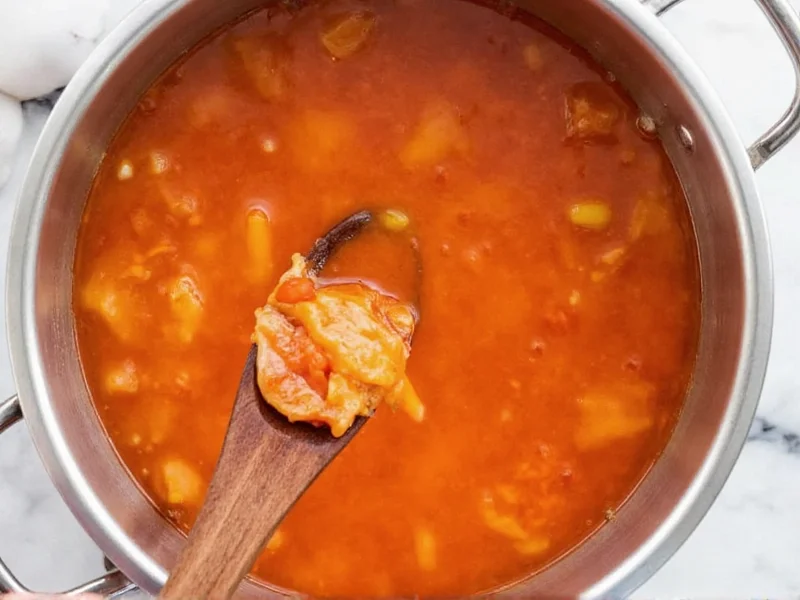Kimchi jjigae stands as one of Korea's most beloved comfort foods, transforming simple fermented cabbage into a deeply flavorful, spicy stew. This traditional Korean dish balances tangy, spicy, and savory elements in perfect harmony. What makes this recipe special is its reliance on properly aged kimchi—the cornerstone of authentic flavor development. Many home cooks make the mistake of using fresh kimchi, which lacks the necessary sour complexity. Our tested method ensures you achieve restaurant-quality results with pantry staples and proper technique.
Essential Ingredients for Authentic Kimchi Soup
The magic of kimchi jjigae lies in ingredient quality and proper ratios. Unlike many online recipes, this version specifies exact measurements while explaining why each component matters. Using ingredients past their prime or incorrect proportions creates imbalance—a common reason homemade versions disappoint.
| Ingredient | Amount | Why It Matters |
|---|---|---|
| Aged kimchi (3+ weeks) | 3 cups, chopped | Provides necessary sourness; fresh kimchi won't develop proper depth |
| Pork belly or spam | 8 oz, thinly sliced | Adds richness; traditional protein that balances kimchi's acidity |
| Kimchi juice | 1/2 cup | Concentrated flavor base; don't discard when chopping kimchi |
| Soft tofu | 1/2 block | Absorbs flavors without breaking; firm tofu won't integrate properly |
| Gochujang (Korean chili paste) | 1 tbsp | Deepens spice profile; regular chili paste lacks fermented complexity |
Step-by-Step Cooking Process
Follow these precise steps for optimal flavor development. Timing and technique matter more than ingredient count in this deceptively simple dish.
- Dry-fry the kimchi: In a dolsot (stone pot) or heavy-bottomed pot, stir-fry chopped kimchi over medium heat for 5-7 minutes until it darkens slightly and releases juices. This crucial step concentrates flavors—skipping it creates watery, weak broth.
- Add aromatics: Stir in minced garlic (3 cloves), sliced onion (1 medium), and gochujang. Cook 2 minutes until fragrant.
- Incorporate protein: Add pork belly slices and stir-fry until lightly browned (3-4 minutes). The fat renders essential flavor into the broth.
- Build the broth: Pour in 3 cups anchovy-kelp broth (or water with 1 tbsp fish sauce) gradually while scraping browned bits from pot bottom.
- Simmer for depth: Bring to gentle boil, then reduce heat and simmer uncovered for 20 minutes. This develops complex flavors—rushing creates harsh, one-dimensional soup.
- Add tofu and finish: Gently fold in cubed tofu and sliced green onions. Simmer 5 more minutes. Taste and adjust with salt if needed.
Pro Techniques from Korean Kitchen Experience
After making kimchi jjigae weekly for over a decade, these insights separate good from exceptional:
- Kimchi age matters most: Use kimchi fermented at least 21 days. The lactic acid development creates the signature tang that defines authentic jjigae.
- Broth alternatives: While anchovy-kelp broth is traditional, adding 1 dried shiitake mushroom to water creates excellent vegetarian version without compromising depth.
- Texture control: For thicker stew, mash some kimchi against pot side during simmering. For clearer broth, avoid over-stirring tofu.
- Heat management: Maintain gentle simmer—rolling boil makes pork tough and clouds broth unnecessarily.
Avoid These Common Kimchi Soup Mistakes
Even experienced cooks stumble with these pitfalls:
- Using fresh kimchi: Results in overly spicy, one-dimensional flavor. Properly aged kimchi provides necessary sour counterpoint.
- Adding all liquid at once: Dilutes flavors. Gradual addition builds layered complexity.
- Overcooking tofu: Causes it to disintegrate. Add during final 5 minutes only.
- Skipping the dry-fry step: Creates weak broth lacking umami depth. This concentrates kimchi's natural glutamates.
- Using water instead of seasoned broth: Creates flat-tasting soup. Even simple fish sauce water elevates flavor significantly.
Variations for Different Dietary Needs
Adapt this traditional recipe while maintaining authentic flavor profile:
- Vegan kimchi soup: Substitute pork with mushrooms (½ cup shiitake + ½ cup oyster mushrooms), use mushroom broth, and add 1 tsp soy sauce for umami.
- Seafood kimchi stew: Replace pork with 8 oz clams and 6 oz shrimp. Add seafood during last 8 minutes of cooking.
- Quick weeknight version: Use 2 cups aged kimchi + 1 cup kimchi juice with 2 cups broth. Simmer 15 minutes instead of 20.
- Extra hearty meal: Add ½ cup cooked rice or udon noodles directly to finished soup.
Serving and Storage Tips
Maximize enjoyment with these final touches:
- Serve immediately in the cooking pot to maintain temperature—kimchi jjigae tastes best piping hot
- Accompany with steamed rice and Korean side dishes (banchan) for complete meal
- Store leftovers in airtight container for up to 3 days—flavors improve overnight
- Reheat gently on stove (not microwave) to preserve texture and flavor balance
- Freeze for up to 2 months; thaw overnight before reheating











 浙公网安备
33010002000092号
浙公网安备
33010002000092号 浙B2-20120091-4
浙B2-20120091-4